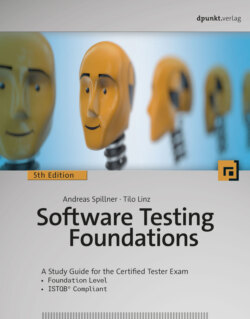Читать книгу Software Testing Foundations - Andreas Spillner - Страница 25
2.3.4 Test Design
ОглавлениеHow to test and which test cases to use
When designing tests you determine how you are going to test. At the design stage, test conditions are used to create test cases (or sequences of test cases). Here, you will usually use one of the test techniques detailed in Chapter 5.
Test cases can be specified on two “levels”: abstract and concrete (see Case Study: Abstract and concrete test cases below).
Abstract and concrete test cases
An abstract (or “high-level”) test case doesn’t include specific input values or expected results, and is described using logical operators. The advantage of such cases is that they can be used during multiple test cycles and with varying data but can still adequately document the scope of each case. A concrete (or “low-level”) test case uses specific input data and expected result values.
When you begin to design a test, you can use abstract as well as concrete test cases. Because only concrete test cases can be executed on a computer, abstract test cases have to be fleshed out with real input and output values. In order to utilize the advantages of abstract test cases (see above), you can derive abstract test cases from concrete cases too.
Test cases involve more than just test data
Preconditions have to be defined for every test case. A test also requires clear constraints that must be adhered to. Furthermore, you need to establish in advance what results or behavior you expect the test to produce. In addition to output data, results include any changes to global (persistent) data and states, as well as any other reactions to the execution of the test case.
The test oracle
You need to use adequate sources to predict test results. In this context, people talk about the “test oracle” that has to be “consulted” regarding the expected results. For example, specifications can serve as an oracle. There are two basic approaches:
The tester derives the expected output value from the input value based on the test object’s requirements and specifications as defined in the test basis.
If the inverse of a function exists, you can execute the inverse and compare its output with the input value for your original test case. This technique can, for example, be used when testing encryption and decryption algorithms
The following example illustrates the difference between abstract and concrete test cases.
Case Study: Abstract and concrete test cases
A dealership can give its salespeople the option of discounts to apply to the price of a vehicle. For prices below $15,000 there is no discount. For prices up to $20,000, a discount of 5% is appropriate. If the price is below $25,000, a 7% discount is possible. If the price is above $25,000, a discount of 8.5% is to be applied.
The above text enables us to derive the following relationships between price and discount:
| Price < 15,000 | Discount = 0% |
| 15.000 ≤ Price ≤ 20,000 | Discount = 5% |
| 20.000 < Price < 25,000 | Discount = 7% |
| Price ≥ 25,000 | Discount = 8.5% |
The text itself obviously offers potential for interpretation13. In other words, the text can be misunderstood, whereas the mathematical formulae derived from it are unambiguous.
Based on the formulae, we can define the following test cases (see table 2-2):
Table 2-2 Abstract test cases
In order to execute these tests, the abstract cases have to be converted to concrete cases—i.e., we have to apply specific input values (see table 2-3). Exceptional conditions and boundary cases are not covered here.
Table 2-3 Concrete test cases
The values shown here serve only to illustrate the difference between abstract and concrete test cases. We didn’t use a specific test technique to design these tests, and the cases shown aren’t meant to test the discount component exhaustively. For example, there is no test case that covers false input (such as a negative price). You will find more detail on the systematic creation of test cases using a specific test technique in Chapter 5.
In addition to specifying abstract and concrete test cases, test design also includes prioritizing your test cases and providing appropriate testing infrastructure:
Priorities and traceability
Test analysis has already prioritized the test conditions. These same priorities can be used and fine-tuned for your test cases (or sets of test cases). This way, you can assign different priorities to the individual tests within a set that are designed to verify a single test condition. High- priority tests are executed first.The same principle applies to the traceability of test conditions, which can be broken down to cover individual test cases or sets of cases.
Testing infrastructure and environment
The required testing infrastructure has to be evaluated and implemented. Test infrastructure consists of all the organizational elements required for testing. These include the test environment, testing tools, and appropriately equipped workstations. A test environment is required in order to run the test object on a computer and verify the specified test cases (see below). This environment comprises hardware, any necessary simulation equipment and software tools, and other supporting materials. In order to avoid delays while testing, the test infrastructure should be up and running (and tested) before testing begins.
Following on from the test analysis, the test design stage can reveal further defects in the test basis. Likewise, test conditions that were defined at the analysis stage can be fine-tuned at the design stage.
